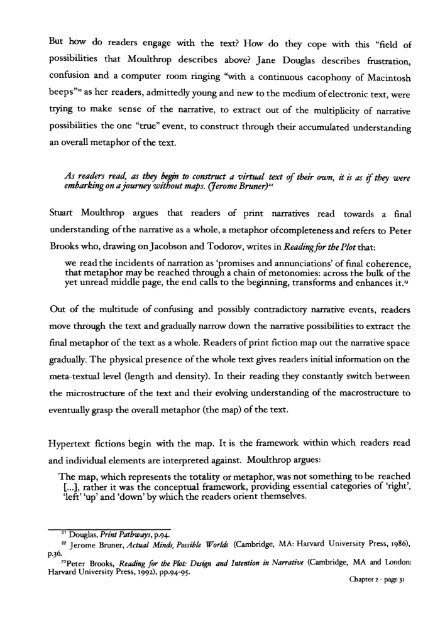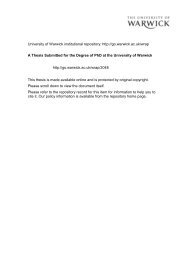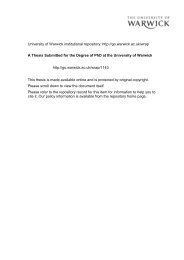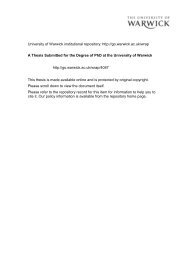From Page to Screen - WRAP: Warwick Research Archive Portal ...
From Page to Screen - WRAP: Warwick Research Archive Portal ...
From Page to Screen - WRAP: Warwick Research Archive Portal ...
Create successful ePaper yourself
Turn your PDF publications into a flip-book with our unique Google optimized e-Paper software.
But how do readers engage with the text? How do they cope with this "field of<br />
possibilities that Moulthrop describes above? Jane Douglas describes frustration,<br />
confusion and a computer room ringing "with a continuous cacophony of Macin<strong>to</strong>sh<br />
beeps?" as her readers, admittedly young and new <strong>to</strong> the medium ofelectronic text, were<br />
trying <strong>to</strong> make sense of the narrative, <strong>to</strong> extract out of the multiplicity of narrative<br />
possibilities the one "true" event, <strong>to</strong> construct through their accumulated understanding<br />
an overall metaphor ofthe text.<br />
As readers read, as they begin <strong>to</strong> construct a virtual text of their oum, it is as if they were<br />
emharking onajourney without maps. (Jerome Bruner)"<br />
Stuart Moulthrop argues that readers of print narratives read <strong>to</strong>wards a final<br />
understanding ofthe narrative as a whole, a metaphor ofcompletenessand refers <strong>to</strong> Peter<br />
Brooks who, drawing onJacobson and Todorov, writes in ReadingforthePlotthat:<br />
we read the incidents ofnarration as 'promises and annunciations' offinal coherence,<br />
that metaphor may be reached through a chain ofme<strong>to</strong>nomies: across the bulk ofthe<br />
yet unread middle page, the end calls <strong>to</strong> the beginning, transforms and enhances it."<br />
Out of the multitude of confusing and possibly contradic<strong>to</strong>ry narrative events, readers<br />
move through the text andgradually narrow down the narrative possibilities <strong>to</strong> extract the<br />
final metaphor of the text as a whole. Readers ofprint fiction map out the narrative space<br />
gradually. The physical presence ofthe whole text gives readers initial information on the<br />
meta-textual level (length and density). In their reading they constantly switch between<br />
the microstructure of the text and their evolving understanding of the macrostructure <strong>to</strong><br />
eventually grasp the overall metaphor (the map) ofthe text.<br />
Hypertext fictions begin with the map. It is the framework within which readers read<br />
and individual elements are interpreted against. Moulthrop argues:<br />
The map, which represents the <strong>to</strong>tality or metaphor,was not something <strong>to</strong> be reached<br />
[...), rather it was the conceptual framework, providing essential categories of 'right',<br />
'left' 'up' and 'down' bywhich the readers orient themselves.<br />
21 Douglas, Print Pathways, P.94.<br />
22 Jerome Bruner, Actual Minds, Possible Worlds (Cambridge, MA: Harvard University Press, 1986),<br />
P·36.<br />
23Peter Brooks, Reading for the Plot: Design and Intention in Narrative (Cambridge, MA and London:<br />
Harvard University Press, 1992) , PP.94-95.<br />
Chapter 2 - page 3I





